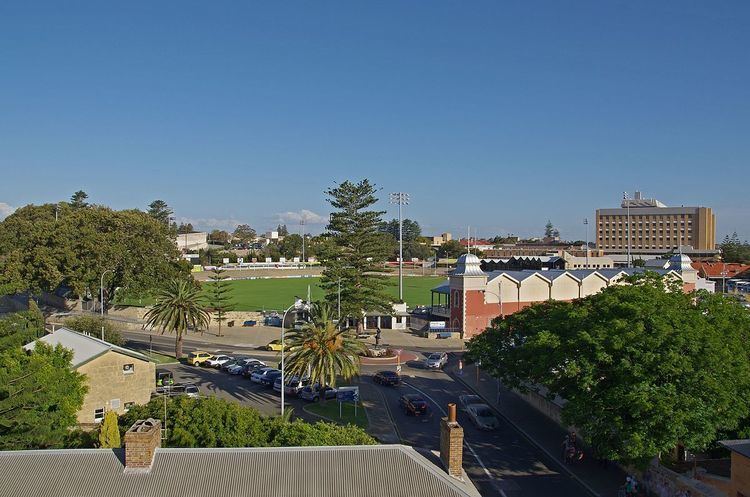Record attendance 23,109 Opened 1895 Construction cost 3,579 GBP | Surface Grass Capacity 17,500 | |
 | ||
Hours Open today · Open 24 hoursFridayOpen 24 hoursSaturdayOpen 24 hoursSundayOpen 24 hoursMondayOpen 24 hoursTuesdayOpen 24 hoursWednesdayOpen 24 hoursThursdayOpen 24 hours Similar East Fremantle Oval, Leederville Oval, Lathlain Park, Bassendean Oval, Claremont Oval | ||
Pink floyd east fremantle oval australia news reports feb 25th 1988
Fremantle Oval (originally known as Barracks Green Field) is a stadium in the centre of Fremantle, Western Australia, located on Parry Street. It currently has a capacity of 17,500 with terracing and a members area holding 750, though capacity was capped at 10,000 for Fremantle AFLW games. Fremantle Oval was originally used for cricket, but in 1895 hosted its first game of Australian rules football and Australian Football quickly became the main attraction leading to the development of the ground. It is located between the Fremantle Hospital, Fremantle Markets and the Fremantle Prison.
Contents
- Pink floyd east fremantle oval australia news reports feb 25th 1988
- 7 sports news fremantle dockers say goodbye to fremantle oval 16 2 17
- History
- Record crowd
- References
The ground was the training and administrative home of the Fremantle Football Club until February 2017, and has also hosted pre-season matches featuring Fremantle. South Fremantle Football Club, the Bulldogs, train and play their home WAFL matches here and are one of the few sporting organisations in Western Australia to own their club rooms freehold, rather than on a long-term lease.
7 sports news fremantle dockers say goodbye to fremantle oval 16 2 17
History
Originally known as Barracks Green Field, the area was used by the Pensioner Guards who were used primarily as guards for Fremantle Prison which house convict and ticket of leave prisoners. In 1861 Manning raised a Volunteer defence force, who used the ground for manoeuvers, parades with volunteer bands providing entertainment.
As Australian Rules Football developed in the late 19th century the ground became the base for the Fremantle Football Club and hosted many early WAFL as well as interstate games. Facilities remained relatively basic until 1897 when the Victoria Pavilion was built. The large stately structure provided seating for 500 people as well as club rooms located in the basement.
By 1901 South Fremantle Football Club and East Fremantle Football Club were established as regular cotenants of Fremantle Oval. the oval also hosted Fremantle Cricket Club and a cycling track that was in regular use throughout the year.
East Fremantle Football Club vacated the ground in 1950, moving to new premises, located at Moss Street in East Fremantle.
In 1954 the oval was used for a ceremonial parade as part of Queen Elizabeth II's first visit to Fremantle.
The Cycling Track and Cricket Pitch were removed in the 1960s due to the increasing demands of WAFL football.
The ground remained relatively unchanged until 1968 when the South Fremantle Football Club acquired a portion of land freehold at the hospital end of the ground for the construction of social club, members pavilion and players changerooms.
Further improvements were made to the ground with the growing demands of larger WAFL crowds in the 1960s and 1970s. These included a shelter behind the goals at the prison end of the ground and a large one at the hospital end of the ground named the Doig Pavilion. A three level press box was constructed adjacent to the Victoria Pavilion. The eastern outer area of the ground was also fully terraced with concrete kerbing so as to allow for greater crowd capacity.
The late 1970s witnessed a peak in crowd attendance at Fremantle Oval with over 23,000 people attending the Foundation Day Derby in 1979. Large crowds continued to flock to the ground into the early 1980s with the WAFL proving to be the most popular spectator sport in the State.
From 1980 to 1985 the oval hosted Motorcross racing during the summer. Noise complaints from nearby Fremantle Hospital and the availability of more suitable venues lead to the racing moving.
In 1984 the ground underwent its most dramatic structural change with the works related to the Parry Street extension, demolishing the historic Henderson Street and South Terrace entrance gates as well reducing the capacity of the ground on the western side. New entrance gates were built on Parry Street, however the South Terrace gates were never replaced.
In 1987, the entry of the West Coast Eagles into the expanded VFL competition lead to a dramatic decline in WAFL attendances. In 1995 this was compounded by the entry of the Fremantle Dockers into the AFL. Attendances dropped from an average of 8000 in the early 1980s to 3000 in the early 90's and 2000 in 1999.
The Fremantle Dockers established a base at the oval and in 1999 constructed a new training facility. This required the demolition of the Doig Pavilion and the leveling of the historic hospital end hill area that had once been one of the most popular positions for the general public to watch football matches from.
The oval continues to host WAFL matches as well as AFL pre season games.
It is also used a venue for conferences, rock concerts (including the Big Day Out) and exhibitions.
Record crowd
23,109, when South Fremantle beat East Fremantle on 4 June 1979.
